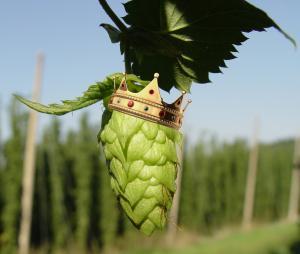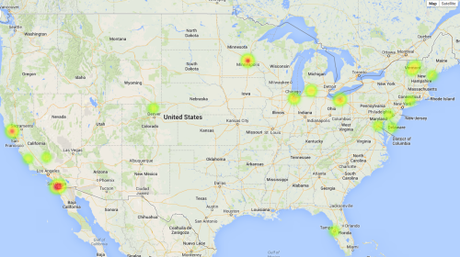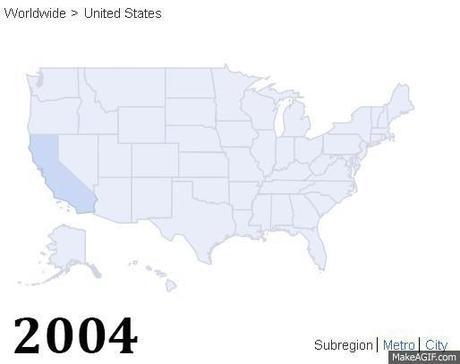
When it comes to understanding craft beer, perhaps the only thing bigger than the idea of its “cultural movement” is ironically one, singular brew – the IPA.
The India pale ale has become synonymous with craft beer and stands tall as arguably the most popular style for Americans picking up bottles or downing pints of Sierra Nevada, Lagunitas, New Belgium or any local option down the street.
As the IPA has taken hold of our pints and wallets, it’s become the cornerstone style for breweries young and old. The IPA has shifted from a novel connection to the West Coast to a beer found everywhere across the country.
So if California, Oregon and Washington no longer reign over the IPA-loving masses like they used to, where exactly are today’s best IPAs coming from?
Last week, Carla Jean Lauter, aka “The Beer Babe,” looked into just that, dissecting the East Coast’s place among the elite IPA producers. I highly suggest you take a look at all the data Carla compiled, which leaned toward New England as the best, new spot for IPAs.
With Carla’s idea in mind and a little more number crunching, I wanted to see if extra tests to the East Coast-West Coast IPA “rivalry” would expand our understanding of what the IPA means to the craft beer community and where the “best” versions of the style come from.
I started with data from Beer Advocate, which offers its top 250 beers as voted on by users of the site. All scores are out of a maximum of five and weighted using a Bayesian estimate. This is all to say the site tries to balance out ratings a bit.

Who is king of the IPA?
In Carla’s research, she mapped the top-50 IPAs from the list, which include obvious names like Pliny the Elder and Younger from California’s Russian River and The Alchemist’s Heady Topper, of Vermont.
I wanted to narrow our options even more, so instead of grabbing the top-50, I set a rule of a minimum 1,000 ratings for an IPA out of Beer Advocate’s entire top-250. That means Toppling Goliath’s King Sue is no longer eligible, as it has just 351 ratings as well as a beer like New England Brewing’s Fuzzy Baby Ducks IPA, which has only been rated 239 times.
My assumption here was that even though Beer Advocate tries to balance ratings, more ratings from users has potential to even things out, and also takes away random one-offs or super-exclusive IPAs that might inflate scores due to bias.
In theory, we’re including beers that are available to a wider IPA-loving audience.
Out of all the 250 top-rated beers on Beer Advocate, this left me with 34 eligible IPAs from across the US, at the time of data collection. Here’s what a heat map of these look like, weighted by their Beer Advocate score of one to five (click to enlarge):

Vermont gets a big boost with three of the top-five beers from The Alchemist, Lawson’s Finest Liquids and Hill Farmstead, but California is still looking pretty good with 13 overall placements.
However, what’s interesting isn’t whether the best IPAs are coming from the West or East coasts – now there’s an argument to be made for the Midwest. Here are the regional breakdowns of the 34 beers (Colorado is lumped in with West Coast):
Region
Top IPAs
West Coast 14
Midwest 11
East Coast 9
Why this makes sense
If the West Coast was the birth place of the American IPA in the 1980s thanks to places like Oregon’s Bridgeport (or Anchor Brewing before it), it started its rise as an East Coast staple in 1993 with Harpoon’s “New England” IPA and pushed further by Dogfish Head and their “Minute” brand IPAs.
In terms of interest, previous research hinted that Midwest residents may have been “late” to craft beer, but in terms of our modern obsession with IPAs, they’re right on time.
For example, this Google Trends chart shows searches for “IPA” across the country from 2004 to 2013, with darker blues indicating heavier search rates:

Knowing that IPA sales have rapidly increased over the years, it make sense that as new breweries come online and new beers are created, regional interest in IPA and the reliance on making a standout IPA also go up. Hence the latest and greatest from the IPA “newbies” of the East Coast and Midwest.
Sorted by region, the average year in which Beer Advocate’s 34 IPAs started receiving rankings is roughly the same (2007), but thinking about it in terms of public knowledge of these breweries, it’s only recently that people became curious about these IPA behemoths of the East Coast and Midwest.
Therein lies an interesting point when it comes to the geographical test – it’s not just where the IPAs were made, but when.

The hotspots of Midwest IPA production. Click to enlarge.
More established Midwest breweries, like Minneapolis Town Hall Brewery (1997), came into business after both coasts were introduced to the IPA. But even then, top-flight Midwestern India pale ales are more recent.
Minneapolis’ Surly Brewing, which produced Abrasive Ale, Furious and Wet on the Beer Advocate list, has been around since 2005. Ohio’s Fat Head’s, which offers Head Hunter IPA, began in 2009. Minneapolis Town Hall’s Masala Mama IPA received its first rating on Beer Advocate in 2003.
To boot, those top-rated Vermont breweries on Beer Advocate’s list also follow suit with The Alchemist (2003), Lawson’s Finest Liquids (2008) and Hill Farmstead (2010) all opening after IPA interest took hold. Beers like Jai Alai (Cigar City, 2007), On the Wings of Armageddon (DC Brau, 2009) and Lunch (Maine Beer, 2009) are also top-notch IPAs from new businesses.
From this perspective, it makes sense that newer beers of the East Coast and Midwest might rank highly – IPAs were selling, the industry had matured and consumers tastes shifted toward hop-forward brews. New breweries not only needed to have an IPA, but make one that stands out among crowded field. After all, beer enthusiasts not only seek out new, novel and unique beers, but rate them highly as well.
Combine this with the ever-increasing focus on locally-sourced beer (as Carla points out, too) and you’ll find breweries who are new, content with their small footprint and opening up in previously underserved areas of the country. All of a sudden, fresh IPA finds its way into the hands of consumers and voila – some of the best versions of the style now come from new locales.
But Beer Advocate rankings don’t tell the whole story. There’s another piece – and another ratings site – to consider.
+Bryan Roth
“Don’t drink to get drunk. Drink to enjoy life.” — Jack Kerouac

